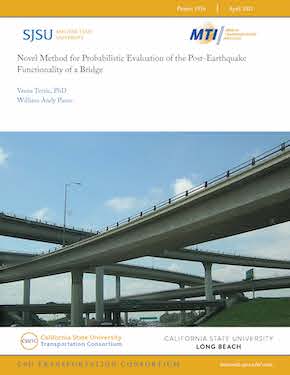- 408-924-7560
- mineta-institute@sjsu.edu
- Donate
Novel Method for Probabilistic Evaluation of the Post-Earthquake Functionality of a Bridge
While modern overpass bridges are safe against collapse, their functionality will likely be compromised in case of design-level or beyond design-level earthquake, which may generate excessive residual displacements of the bridge deck. Presently, there is no validated, quantitative approach for estimating the operational level of the bridge after an earthquake due to the difficulty of accurately simulating residual displacements. This research develops a novel method for probabilistic evaluation of the post-earthquake functionality state of the bridge; the approach is founded on an explicit evaluation of bridge residual displacements and associated traffic capacity by considering realistic traffic load scenarios.
This research proposes a high-fidelity finite-element model for bridge columns, developed and calibrated using existing experimental data from the shake table tests of a full-scale bridge column. This finite-element model of the bridge column is further expanded to enable evaluation of the axial load-carrying capacity of damaged columns, which is critical for an accurate evaluation of the traffic capacity of the bridge. Existing experimental data from the crushing tests on the columns with earthquake-induced damage support this phase of the finite-element model development.
To properly evaluate the bridge's post-earthquake functionality state, realistic traffic loadings representative of different bridge conditions (e.g., immediate access, emergency traffic only, closed) are applied in the proposed model following an earthquake simulation. The traffic loadings in the finite-element model consider the distribution of the vehicles on the bridge causing the largest forces in the bridge columns.
VESNA TERZIC, PhD
Vesna Terzic is an Associate Professor at the Department of Civil Engineering and Construction Engineering Management, California State University, Long Beach (CSULB). She received her BS from the University of Belgrade, Belgrade, Serbia; her MS from Saints Cyril and Methodius University, Skopje, Macedonia; and her PhD from the University of California, Berkeley. Dr. Terzic's expertise includes the development of advanced models and tools for seismic performance assessment and resilience evaluation of civil infrastructure, evaluation of the nonlinear dynamic behavior of structures and their protective systems, and probabilistic performance-based seismic design and evaluation of bridges and buildings. She is a recipient of the prestigious ACI Chester Paul Siess Award for Excellence in Structural Research.
WILLIAM PASCO
William Pasco is a licensed Engineer-in-Training (EIT) who is a graduate student at California State University, Long Beach (CSULB) working towards his Master of Science in Civil Engineering with a focus in Structural Engineering. He obtained his degree of Bachelor of Science in Civil Engineering in the Spring of 2017 from CSULB, graduating magna cum laude. He obtained the Award for Department Outstanding Baccalaureate Graduate in the Spring of 2017 from the CSULB College of Engineering for his exemplary academic record and his engagement in various extracurricular activities. He also achieved an Award of Excellence for Upperclassman of the Year in the Spring of 2017 from the CSULB chapter of the American Society of Civil Engineers (ASCE) for his continued involvement with the organization and his many contributions.
-
Contact Us
San José State University One Washington Square, San Jose, CA 95192 Phone: 408-924-7560 Email: mineta-institute@sjsu.edu






